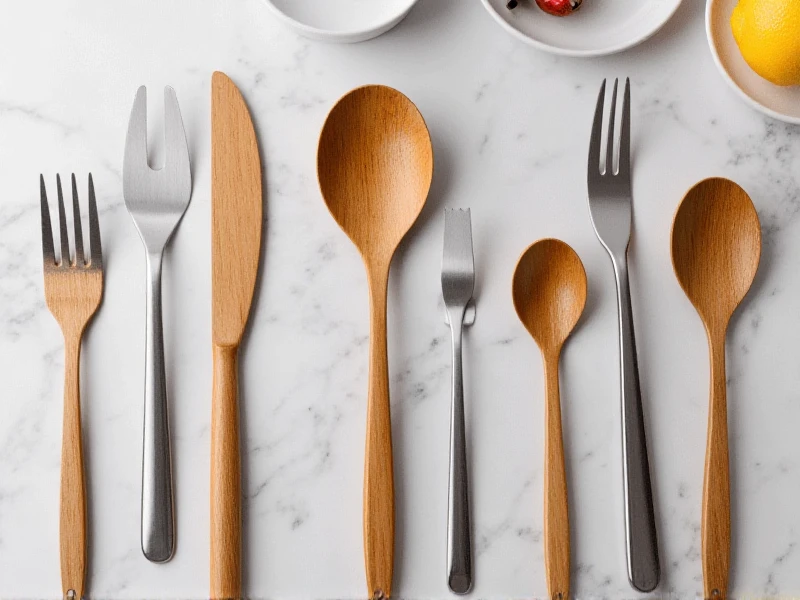Kitchenware Essentials: Your Ultimate Guide to a Functional and Stylish Kitchen (2024)
2025-06-07

A well-equipped kitchen is more than just a cooking space; it's the heart of home, a hub for creativity, and a source of daily nourishment and joy. The right kitchenware empowers you to cook efficiently, safely, and with pleasure, transforming meal preparation from a chore into an enjoyable ritual. Whether you're a novice cook just starting out or a seasoned pro aiming to refine your workspace, understanding essential kitchenware is the foundation. This guide explores the must-have tools that make up a functional and stylish kitchenware collection.
The Foundation: Cookware You Can't Do Without
No kitchenware arsenal is complete without reliable cookware: the pots and pans that do the heavy lifting.
1. Saucepans: Essential for boiling pasta, making soups and sauces, or reheating leftovers. Choose sizes like 1.5-quart, 3-quart, and sometimes 4-quart for versatility. Look for heavy-bottomed options (like tri-ply stainless steel) that distribute heat evenly, preventing hot spots and scorching. A lid is non-negotiable.
2. Skillets/Frying Pans: The workhorses for sautéing, searing, frying eggs, or making pancakes. A 10-inch or 12-inch skillet is incredibly versatile. Consider non-stick coatings for delicate foods like eggs and fish, but a well-seasoned cast iron or durable stainless steel skillet offers unparalleled searing power and longevity.
3. Stockpot: Larger than a saucepan, crucial for making big batches of soup, stock, pasta for a crowd, or boiling corn. Typically 8-quarts or larger. Opt for quality materials to handle the weight and prolonged heat.
4. Dutch Oven: This heavy, thick-walled pot (enameled cast iron is highly popular) is a game-changer. It excels at slow cooking, braising, stewing, baking bread, and deep frying. Its heat retention is exceptional. A 5.5-quart or 7-quart size is highly practical.
Sharp Tools: Knives and Cutting Essentials
Sharp, reliable knives are arguably the most important kitchenware safety and efficiency tools.
1. Chef's Knife (8-inch): Your go-to tool for 90% of cutting tasks – dicing onions, chopping herbs, slicing meat. Invest in quality and keep it honed and sharpened regularly. Comfort and balance are key.
2. Paring Knife (3-4 inch): Perfect for intricate tasks like peeling fruit, segmenting citrus, deveining shrimp, and detailed garnishes.
3. Serrated Knife: Essential for slicing bread without crushing it, and also great for tomatoes.
4. Cutting Boards: Protect your knives and counters. Have at least two: one for raw meat/poultry/fish and one for produce, cheese, cooked items. Wood (maple, bamboo) and plastic are common; heavy-duty composite boards offer durability. Choose sizes that offer ample workspace.
Preparation & Measuring: Precision Matters
Accurate kitchenware tools build culinary confidence.
1. Mixing Bowls (Nested Set): Crucial for combining ingredients. Stainless steel offers durability and lightness, glass is microwave-safe and lets you see contents. Aim for variety: small, medium, and large.
2. Measuring Cups (Liquid): Transparent cup with pour spout and marked increments for measuring liquids accurately. Usually holds 1-4 cups.
3. Measuring Cups (Dry): Stackable cups for dry ingredients like flour and sugar. Usually include 1/4 cup, 1/3 cup, 1/2 cup, and 1 cup sizes. Level off ingredients with a straight edge (like a knife).
4. Measuring Spoons: Set for teaspoons and tablespoons, crucial for spices, baking powder, extracts, salt, etc. Stainless steel is durable and precise.
Essential Utensils and Gadgets
These tools handle the cooking process itself.
1. Spatulas:
High-heat Spatula: Silicone head is heat-resistant and flexible, perfect for scraping bowls and scraping non-stick pans without damage.
Turner/Metal Spatula: For flipping burgers, pancakes, or fish. Look for a sturdy slotted design to allow grease to drain.
2. Tongs: Spring-loaded stainless steel tongs are indispensable for flipping, turning, grabbing hot items, and tossing salads. Locking feature for storage is useful.
3. Wooden Spoon: Gentle on cookware surfaces and doesn't conduct heat. Ideal for stirring sauces and sautéing.
4. Whisk (Balloon or Flat): Essential for incorporating air into mixtures (whipping eggs, cream), emulsifying sauces, and ensuring smooth batters.
5. Colander: For draining pasta, washing vegetables, and rinsing berries. Stainless steel or sturdy plastic are good choices.
6. Peeler (Y-style): Effortlessly peel fruits and vegetables. More ergonomic than traditional swivel peelers.
Choosing Your Kitchenware Wisely
When selecting your kitchenware, consider:
Material: Durability, heat conductivity (cast iron vs stainless vs aluminum core), non-reactivity (avoid aluminum for acidic foods unless coated), ease of cleaning. Non-stick requires silicone or wood utensils.
Quality over Quantity: Investing in well-made, durable core pieces is smarter than filling drawers with cheap items that need frequent replacing.
Your Cooking Style: Do you stir-fry frequently? Prioritize a carbon steel wok or robust skillet. Bake bread? A Dutch oven is key. Minimalist cook? Stick to versatile multi-taskers.
Ergonomics: Knives and utensils should feel comfortable and balanced in your hand.
Equipping your kitchen with this essential kitchenware isn't just about filling cabinets; it's about empowering yourself to create delicious food with ease, confidence, and a touch of flair. Focus on acquiring versatile, high-quality foundations. Build your collection thoughtfully, and soon you'll find joy and efficiency in every meal prepared. Revisit your drawers today – do you have these essentials covered?
Category: